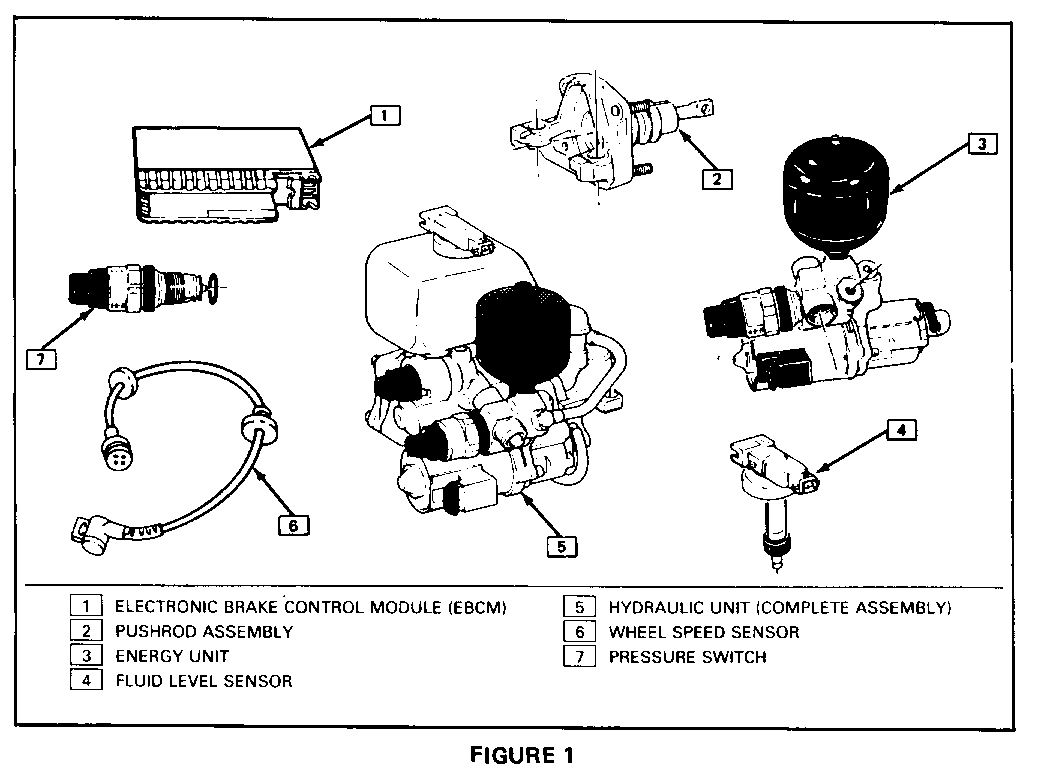ANTI-LOCK BRAKE SYSTEM COMPONENT EXCHANGE PROGRAM

ANTI-LOCK BRAKE SYSTEM COMPONENT EXCHANGE PROGRAM
1986 NINETY-EIGHT
To obtain product feedback information on the 1986 Ninety-Eight Anti-lock Brake System, Oldsmobile has established a parts exchange program for certain system components. A complete description of the Anti-lock Brake System and service procedures may be found in Section 5E of the 1986 Oldsmobile Chassis Service Manual.
The following Anti-lock Brake System components will be available only through the exchange program until the end of the 1986 model year or until further notice. Refer to Figure 1. The components involved in the exchange program include the following:
1. Electronic Brake Control Module (EBCM)
2. Wheel Speed Sensors
3. Hydraulic Unit.The hydraulic unit is a complete assembly and will include the booster/master cylinder unit, pump and motor assembly, hydraulic accumulator, pressure switch, valve block, reservoir and cap (with fluid level sensor) and all hoses and seals.
4. Energy Unit. The energy unit consists of the pump and motor assembly, hydraulic accumulator, pressure switch and all necessary seals and mounting hardware.
5. Pressure Switch
6. Pushrod Assembly (hydraulic unit mounting bracket)
7. Fluid Level Sensor
All other Anti-lock Brake System components will be available through normal WDDGM parts ordering procedures.
Anti-lock Brake System Diagnostic Procedure
When an Anti-lock Brake System condition is encountered, refer to the diagnostics and service procedures in Section 5E of the 1986 Oldsmobile Chassis Service Manual. These procedures should be used to determine which component in the Anti-lock Brake System must be replaced. If a malfunctioning component is isolated, determine if the component is listed on the exchange parts list above. If the part is serviced through WDDGM, use normal parts ordering procedures.
Obtaining An Exchange Component
If an exchange component or any part of an exchange component is isolated as the cause of an Anti-lock Brake System malfunction, contact the Oldsmobile Technical Service Communication System to have a new part shipped. When calling have the following information on hand:
1. Vehicle Identification Number
2. Vehicle Mileage
3. Repair Order Number
4. Failed Part Description
5. Description of Customer Complaint
6. Dealer Shipping Address
The Technical Service Communication System engineer will then determine which component should be exchanged and will make shipping arrangements. Exchange components will be shipped the fastest way at no charge, usually the same day, direct from the source.
Returning Exchange Parts
Upon receipt of the exchange part, dealers should identify the return part using the special tag included with the new component. All information on the tag must be filled out.
Return parts should be securely packaged, using the original shipping containers if possible, and shipped by Parcel Post or United Parcel Service as required to the following address using the label included with the exchange parts: Alfred Teves Technologies, Inc. Customer Service Group 1290 Maplelawn Drive Troy, MI 48084
The replaced parts should be returned as soon as possible after removal from vehicle. All shipments should be freight prepaid.
Warranty Information
Include the freight charges for the return goods in the sublet column on the warranty claim.
The following labor operations which will be included in the Oldsmobile Labor Time Guide first revision are to be used when servicing the Anti-lock Brake System.
Part Name Labor Operation Labor Time --------- --------------- ---------- Control Module H2500 .5
Wheel Speed Sensor Front Right H2410 .3 Left H2411 .3 Both H2412 .5
Rear Right H2414 .3 Left H2415 .3 Both H2417 .5
Hydraulic Unit H2498 1.0
Energy Unit H2499 .5
Pressure Switch H2494 .2
Pushrod Assembly H2485 1.2
Fluid Level Sensor H2493 .2

General Motors bulletins are intended for use by professional technicians, not a "do-it-yourselfer". They are written to inform those technicians of conditions that may occur on some vehicles, or to provide information that could assist in the proper service of a vehicle. Properly trained technicians have the equipment, tools, safety instructions and know-how to do a job properly and safely. If a condition is described, do not assume that the bulletin applies to your vehicle, or that your vehicle will have that condition. See a General Motors dealer servicing your brand of General Motors vehicle for information on whether your vehicle may benefit from the information.
